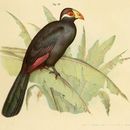en
names in breadcrumbs


S Senegal - NW Cameroon but not in Sierra Leone, Liberia, S Nigeria; N Central African Republic
Gallery and riverine forest, forest edges
Resident
The violet turaco, also known as the violaceous plantain eater (Musophaga violacea), is a large turaco, a group of African otidimorphae.
These are unmistakable birds, but shy and often inconspicuous in the treetops. They are approximately 48 cm (19 in) long, including a long tail and a 4 cm (1.6 in) bill. They boast a winglength of 21 cm (8.3 in)[2] and weigh approximately 360 g. The plumage is glossy violet, except for the yellow forehead, chestnut crown and white ear coverts; the bill is thick and red. In flight, the violet turaco's crimson primary flight feathers contrast with the violet plumage. The red colour in the wings is typical of turacos.
It is resident of West Africa, and has an extremely large range from Senegal through to the Nigeria, with isolated populations in Chad and the Central African Republic. It occurs in tropical savannas, wetlands, woodlands and forests.
Diet consists of fruit, and they are quite partial to figs, but they will also eat leaves, buds, flowers, insects, snails and slugs.
Cooperative breeding behavior has been observed in captivity in this species. The female lays two eggs in a flimsy tree platform nest.
This species is locally common, but is vulnerable to trapping for the pet trade in Guinea, Sierra Leone, Liberia and Ghana.
Turacos are social birds, travelling in flocks of around ten to twelve individuals. They are not strong fliers, preferring to hop along branches. When threatened, they can run quickly through the trees.[3] The violet turaco has a loud “cooroo-cooroo” call.
At Atlanta Zoo, Georgia, USA
![]() Media related to Musophaga violacea at Wikimedia Commons
Media related to Musophaga violacea at Wikimedia Commons
Birds of The Gambia by Barlow, Wacher and Disley, ISBN 1-873403-32-1
The violet turaco, also known as the violaceous plantain eater (Musophaga violacea), is a large turaco, a group of African otidimorphae.